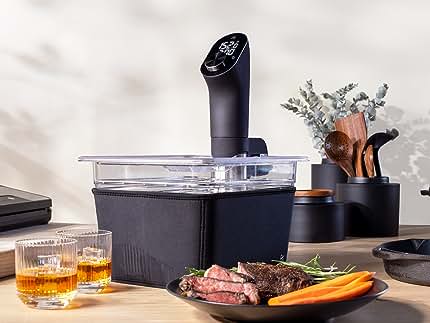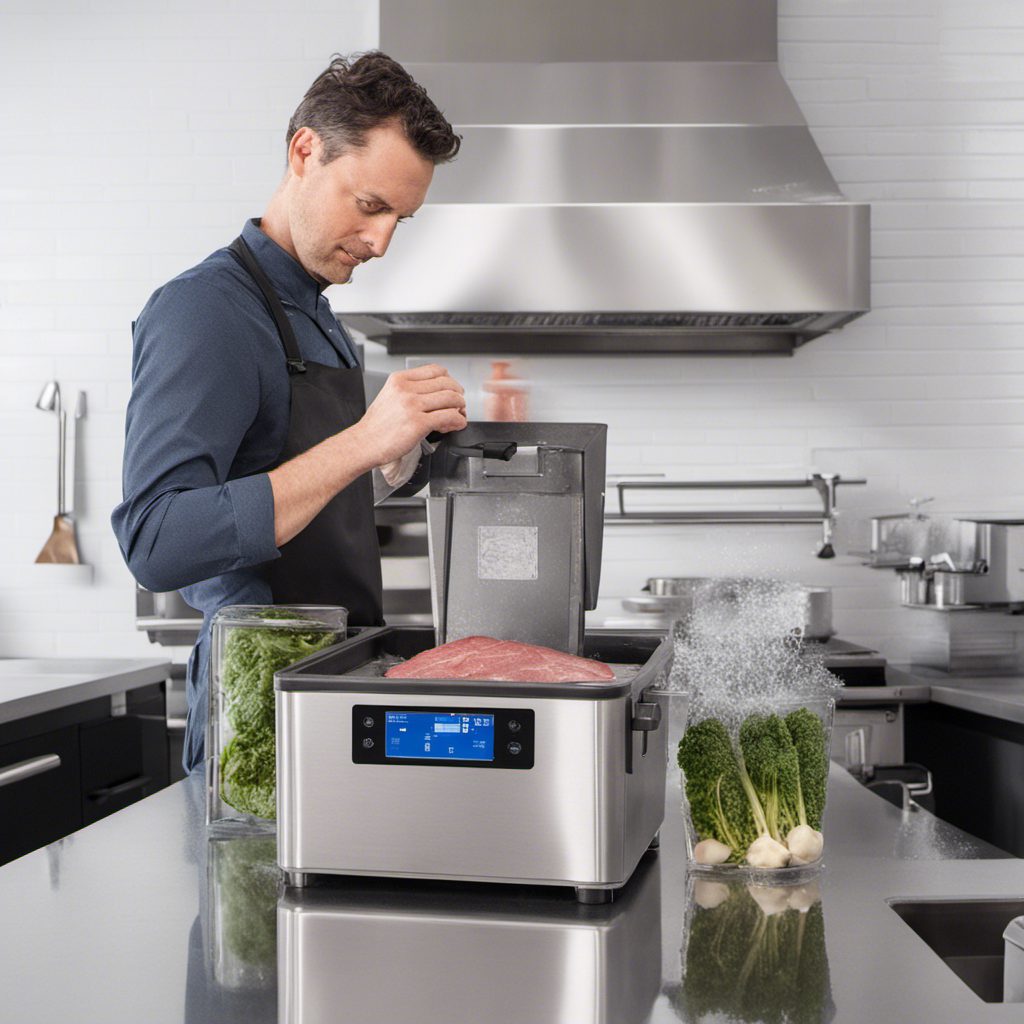Sous vide cooking has revolutionized the culinary world, offering unparalleled precision and consistency in every dish. This method, which translates to ‘under vacuum’ in French, involves cooking food at precise temperatures in vacuum-sealed bags, ensuring perfect doneness every time. In this Sous vide guide, we’ll delve deep into the art of sous vide, exploring its benefits, techniques, and how you can master this innovative cooking method.
Key Takeaways:
- Sous vide offers unparalleled precision in cooking.
- It enhances the natural flavors of the ingredients.
- The method ensures consistent and perfect results every time.
- Sous vide can be used for a variety of foods, from meats to vegetables.
[toc]
What is Sous Vide?

Sous vide is a method of cooking where food is placed in a plastic pouch or glass jar and then cooked in a water bath or steam environment for longer than usual cooking times at an accurately regulated temperature. The temperature is much lower than typically used for cooking, typically around 55 to 60°C (131 to 140°F) for meat and higher for vegetables. The intention is to cook the item evenly, ensuring that the inside is properly cooked without overcooking the outside, and to retain moisture.
Benefits of Sous Vide Cooking
- Consistency: Since you’re cooking your food to a precise temperature for a precise amount of time, you can expect very consistent results.
- Taste: Food cooks in its juices, ensuring that the food is moist, juicy, and tender.
- Waste Reduction: Traditionally cooked steak loses up to 40% of its volume due to drying out. Steak cooked via sous vide, in contrast, loses none of its volume.
- Flexibility: The food can be cooked and held at the desired doneness, which is especially useful for restaurants or home cooks preparing for a party.
Equipment Needed

To get started with sous vide cooking, you’ll need a few essential pieces of equipment:
- Immersion Circulator: This device heats the water to the desired temperature and circulates it to ensure even cooking.
- Sealable Bags: These are used to hold the food while it cooks. Vacuum-sealed bags are preferred, but zip-top bags can also work.
- Water Bath: Any large pot or container can be used as a water bath.
- Thermal Clip: This helps to clip and hold the bags to the side of the water bath.
Sous Vide Cooking Process
- Season and Seal: Season your food as desired and place it in the bag. Remove as much air as possible and seal the bag.
- Set the Temperature: Preheat your water bath to the desired temperature using the immersion circulator.
- Cook: Place the sealed bag in the water bath and let it cook for the desired time.
- Finish: Once cooked, remove the food from the bag. You can then sear, grill, or serve as is.
Popular Sous Vide Dishes

- Steaks: Achieve the perfect doneness from edge to edge.
- Chicken: Get juicy and tender chicken every time.
- Fish: Delicately cook fish to perfection.
- Eggs: Make creamy and soft poached eggs.
- Vegetables: Retain the crunch and vibrant colors of veggies.
Safety Concerns
While sous vide is a safe method of cooking when done correctly, there are some safety concerns to be aware of:
- Temperature: Ensure that the food reaches a safe temperature to kill off any harmful bacteria.
- Time: Foods that are cooked for a long time at low temperatures can be at risk of bacterial growth. Always follow recommended cooking times.
- Storage: If you’re not eating the food immediately after cooking, cool it rapidly in an ice bath and store it in the refrigerator.
Relevant Videos and Resources
Relevant Internal and External Links
- Dr. Douglas Baldwin – Expert in Sous Vide Cooking
- Sous Vide and Compromised Immune Systems
- Do You Have to Sear After Sous Vide?
Frequently Asked Questions (FAQs) about Sous Vide
Why is sous vide so popular?
Sous vide has gained popularity due to its ability to produce consistent results. The precision of the cooking method allows for perfect doneness every time, eliminating the guesswork often associated with traditional cooking methods.
Can I sous vide without special equipment?
While specialized equipment like immersion circulators makes the process easier and more precise, it’s possible to use a stovetop and a thermometer for a makeshift sous vide setup. However, this method requires constant monitoring to ensure the water remains at the desired temperature.
Is sous vide safe?
Yes, sous vide is safe when done correctly. It’s essential to ensure that food reaches a safe temperature to kill off any harmful bacteria. Foods cooked for extended periods at low temperatures should be consumed immediately or cooled rapidly in an ice bath and stored in the refrigerator.
How does sous vide improve flavor?
Sous vide cooking allows food to marinate in its juices, enhancing its natural flavors. Additionally, the slow and gentle cooking process prevents the breakdown of delicate flavor compounds, resulting in a richer taste.
Can I overcook food with sous vide?
While it’s challenging to overcook food using the sous vide method, it’s not impossible. If food is left in the water bath for significantly longer than the recommended time, it can become overly tender or mushy. However, the risk of overcooking in terms of doneness is minimal.
Relevant Internal Links from MensPlayroom
- Innovative Cooking Gadgets for the Modern Man’s Kitchen
- Best Kitchen Gadgets 2023
- Cooking Gadgets for Men
External Resources
- Sous Vide Basics for Beginners
- The Science Behind Sous Vide Cooking
- Sous Vide Time and Temperature Guide
Remember, the art of sous vide cooking is all about precision and patience. By understanding the basics and experimenting with different recipes, you can elevate your culinary skills to new heights. Happy cooking!

Hi I’m Erica Kelly, welcome to my blog! I live in in sunny Florida, I’m a dedicated Miami Dolphins fan and a lover of all things culinary, I explore the world through my travels and share these experiences on this blog. When I’m not on the road or savoring new cuisines, I’m contributing to the healthcare industry with dedication and compassion. My life is a unique tapestry of professional commitment, sports enthusiasm, and an endless pursuit of new adventures.

